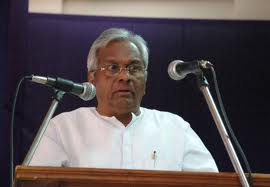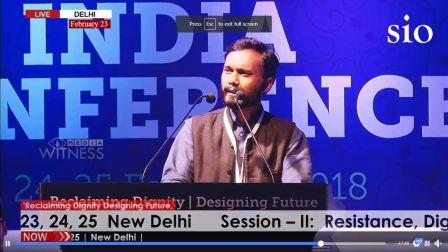Rahul Bansode
 At this hour, the entire world is facing the Covid-19 pandemic, which has brought everything to a standstill. The number of those infected with coronavirus across the globe has crossed almost 46 lakhs with over 3 lakh deaths. World’s most developed countries like USA, Britain, Spain, Italy and many more others have been devastated by corona virus. In India as well, this virus made the government announce a lockdown and many are discussing this lockdown might be further extended, in some form or other.
At this hour, the entire world is facing the Covid-19 pandemic, which has brought everything to a standstill. The number of those infected with coronavirus across the globe has crossed almost 46 lakhs with over 3 lakh deaths. World’s most developed countries like USA, Britain, Spain, Italy and many more others have been devastated by corona virus. In India as well, this virus made the government announce a lockdown and many are discussing this lockdown might be further extended, in some form or other.
It’s better to look back into history when we see darkness all around the world. History may provide some ray of hope. As Dr. Babasaheb Ambedkar said, “They cannot make history who forget history”. This ongoing covid-19 pandemic reminds us of the bubonic plague, the so-called “Third Pandemic,” which erupted in 1855 in the Chinese province of Yunnan. The disease traversed the globe over the next several decades, and by the beginning of the 20th century, infected rats traveling on steamships had carried it to all six inhabited continents. The worldwide outbreak eventually claimed some 15 million lives before petering out in the 1950s. Most of the devastation took place in China and India during this Bubonic Plague.
In the princely state of Kolhapur (Karveer), the young King Chhatrapati Shahu sat on the throne in the year 1894. After Chhatrapati Shahu’s coronation, this princely state of Kolhapur faced a severe famine. To control the situation, he came up with many action plans. To reduce unemployment and make water available for drinking as well as farming he dug wells, ponds and reservoirs and built roads and bridges. The state took care of food and shelter of the destitute, disabled, elderly and poor people during this famine. It ensured fodder for cattle. When the state was on the verge of overcoming the famine, it once again faced another big, and perhaps more severe, challenge of plague. But, Chhatrapati Shahu was a man of vision. He proved to be a worthy heir and lived up to the legacy of Chhatrapati Shivaji, one of the greatest Bahujan kings in history.
In 1896, the Bubonic plague entered the city of Bombay and started spreading in other parts of the Bombay province, like Bhiwandi, Pune. Thousands of people died because of plague in their neighbourhoods. Shahu Maharaj understood the gravity of the situation and reacted quickly without waiting for the plague to enter his state. He swiftly made administrative arrangements and came with precautionary as well as pre-emptive measures to cope with the plague. He came out with proclamations and pronouncements to raise awareness about the plague among his subjects. Those affected people who came to the state from outside locations like Bombay were isolated and kept quarantined for three days at a station named Shirol. All those railway passengers who came from Bombay were provided with medical check-ups. The Kolhapur state appointed and allotted special doctors for this task. Those who were infected by the plague were provided shelters and were given medicines. They were strictly kept in quarantine camps for three days. Chhatrapati Shahu appointed special officers who took care of free food and shelters with hygienic conditions. Now, look at the response from the king in 20th century and compare it with the way the present Indian government responded to the situation. It could have come up with isolation and quarantine policy for those who came from abroad initially and have possibly saved us from the present lockdown situation which is proving dangerous for the Bahujan working class.
Chhatrapati Shahu, came out with a second pronouncement in October 1897 in which he told people to paint walls and floors of houses with lime to prevent plague. He made arrangements for painting with the help of Karveer Municipal Committee for those subjects who couldn’t afford it. Later in the month of December 1897, he came out with another detailed pronouncement in which many rules and regulations regarding health and hygiene were put forth. Through this, guidelines were given regarding quarantine period and how to disinfect grains, clothes, furniture, walls and floor of the house, how to take care of patients, how to dispose of dead rats, how to burn dead bodies. He appointed his diwan as special health officer of the city and brought it under his direct control. Chhatrapati Shahu banned ‘Jatras’ i.e. religious fairs during these times to avoid spread of plague.
During those times, there was a lot misconception, misinformation, ignorance regarding plague. Society at large was superstitious. So, to remove the misconceptions about plague, Chhatrapati Shahu distributed thousands of pamphlets and brought awareness among people through village officers. These pamphlets were read before people and awareness was fostered among people. Now, when there is lot of misinformation and religious propaganda is made by right wing people by claiming cow urine and cow dung being effective medicine for preventing covid-19, isn’t it the duty of the present government to clarify regarding the misinformation and curb it in the interest of nation?
Chhatrapati Shahu ensured availability of cheap food grains through shops. He talked with shop keepers and convinced them to sell food grains at minimal rates and controlled price rise. He ordered them to sell food grains on no-profit and no loss principle. Through various public works, employment opportunities were provided and people were helped in sustaining themselves during the plague epidemic. Even during the time of famine, not a single person died of hunger. Now, wasn’t this a great achievement for a small princely state with minimal resources at its disposal? After the outbreak of plague in Bombay province, there was not a single case of plague for initial three years in his Kolhapur state. Even after taking so many pre-emptive measures when plague finally entered a few parts of the state like Shirol and Gadhinglaj, in the September 1899, state at war footing level fought with plague by establishing clinics and controlled it immediately.. When plague brought havoc to the neighboring areas of Pune, Karad and Sangali, it was all because of extraordinary efforts of visionary Bahujan King Shahu Maharaj of Kolhapur state was saved from plague epidemic.
Chhatrapati Shahu was praised by the British government for his extraordinary work to prevent and curb the plague epidemic in his Kolhapur state. His British teacher Mitford Fraser who was then in Bangalore while praising his tireless efforts said, “I am gratified to read in the papers how highly your subjects appreciated your personal exertions in the matter of plague and famine. Stick to it, Maharajah, this is the time to show what man is made up of”. After ascending the throne, his courage and determination to fight famine and plague, his empathy, sensitivity and care for his subjects gives an ample idea why in the later phase of his rule he came up with revolutionary welfare measures like upliftment of lower castes and those who were stigmatized as criminal tribes by colonial government and society, reservation policy etc. And later, his role in ensuring the rise of Babasaheb Ambedkar as a leader of the depressed classes at Mangaon Parishad exemplifies his progressive character. Shahu Maharaj is an example how the present government should take care of its people during the Covid-19 pandemic: not just make them bang utensils, instead of working hard and being sensitive towards the needs of vulnerable sections of society.
~
References
Rajarshi Shahu Chhatrapati: Ek Abhyas by Vasudha Jaisingrao Pawar.
~~~
Rahul Bansode is pursuing his M.A. in Urban Policy and Governance at TISS, Mumbai.









